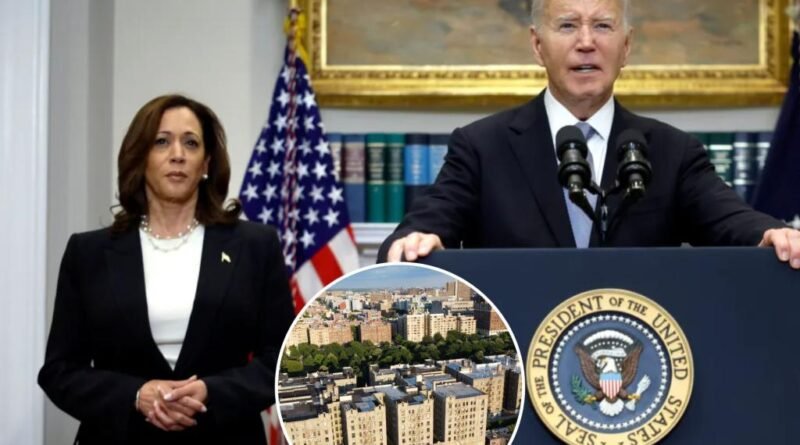Joe Biden and Kamala Harris advocate for rent control – a beneficial policy for improving city living
Few policies raise economists’ ire as much as rent control.
“In many cases,” Swedish economist Assar Lindbeck famously said, “rent control appears to be the most efficient technique presently known to destroy a city—except for bombing.”
Nonetheless, President Biden, along with Vice President Kamala Harris, recently proposed a nationwide rent cap, which would limit rent increases by certain landlords at no more than 5% per year.
Many observers doubtless had a similar reaction to Jason Furman, the former top economic adviser to President Barack Obama, who said: “Rent control has been about as disgraced as any economic policy in the toolkit.”
The rent-control plan is by far the most extreme of the administration’s policies toward landlords, but it is part of a long-term trend.
Soon after Biden entered office, the Centers for Disease Control and Prevention extended a temporary eviction moratorium that had begun under President Donald Trump and had already been extended for one more month by Congress.
The CDC kept extending the moratorium, despite the obvious end of the pandemic emergency, until the Supreme Court struck it down in August 2021.
The administration’s offensive against landlords goes beyond the CDC and reflects a “whole of government” approach.
The Department of Justice assisted an antitrust lawsuit against landlords sharing information online, which the government claimed could be used to raise rents.
The Federal Trade Commission’s proposed rule against “junk fees” cited rental fees as a major target.
The Consumer Financial Protection Bureau issued an “advisory” opinion threatening companies that perform background checks for landlords and others, stating that improper matches could subject them to discrimination lawsuits.

Other agencies have already flirted with direct rent control.
The Federal Housing Finance Agency, the regulator for the government-owned mortgage giants Fannie Mae and Freddie Mac, said that it wanted to “limit egregious rent increases” at rental properties that receive the companies’ support.
The Department of Housing and Urban Development finalized a rule to cap rents in “affordable” units supported by government tax credits, though these units were already rent-restricted, so the effect was minimal.
Some of the thought behind the administration’s anti-landlord campaign can be found in its 19-page “White House Blueprint for a Renters Bill of Rights.”
It advocates a mandatory 30 days’ notice of eviction for renters, which is far more than tenants get even in the most liberal states for nonpayment evictions, and which basically guarantees a rent-free month.
It supports banning “discrimination” against renters using government vouchers, despite the obvious problems such vouchers present to landlords.
The blueprint claims tenants should have the “right to organize”; in other words, it adopts the tenant movement’s idea that renters’ organizations should act like unions in negotiating with landlords.
Some proponents of the White House rent-control proposal note that it would be in effect for only two years and would apply only to already built homes, and therefore wouldn’t affect new construction.
But almost all rent-control laws make such promises; governments often can’t help themselves and keep expanding the laws’ reach anyway.
New York began regulating older buildings’ rents in the 1950s with the implicit promise that new construction would remain uncontrolled.
But in 1974, it extended control to apartments built into the 1970s.
Landlords and developers, twice bitten, remained shy for decades.
Even if rent control remains only on older buildings, the effects can be devastating.
One comprehensive look at 206 rent-control studies shows that these laws cause landlords to withdraw units from the market or cause tenants, including wealthy ones, to stay put.
As a consequence of reduced rental-housing supply, rents go up in the noncontrolled apartments.
The studies also show that housing quality declines rapidly, since landlords can’t afford upkeep.
Rent control was one of the main reasons The Bronx in the 1970s was littered with collapsed or dilapidated apartments.
Although Biden has dropped out of the presidential race, Kamala Harris publicly endorsed the rent-control plan.
Until recently, rent control seemed like an idea headed for the ash heap of history, but the White House’s proposal, even if it can’t get past Congress, is part of a general revival of the idea.
In 2019, Oregon adopted the nation’s at-the-time only statewide rent-control measure, which Kamala Harris celebrated.
Since then, other states and cities have expanded their rent-control programs.
It’s part of a growing attack against people providing rental housing, one that will end poorly for everyone.
Judge Glock is the director of research and a senior fellow at the Manhattan Institute and a contributing editor of City Journal. Adapted from City Journal.



